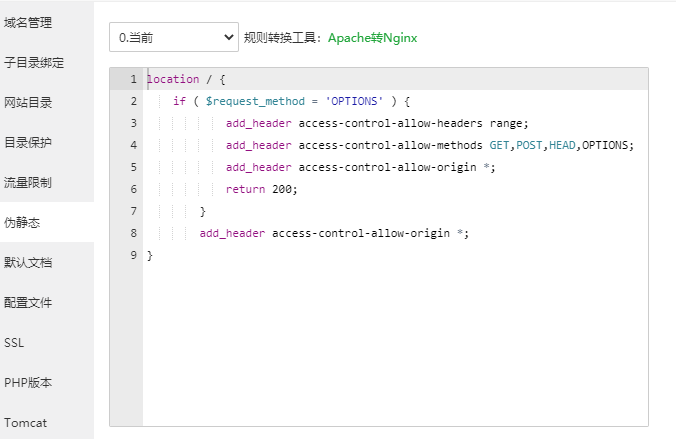一、下载Nginx
解压到C:nginx目录下
二、在两台服务器上分别建一个网站:
S1:192.168.16.35:8054
S2:192.168.16.16:8089
二、找到目录
C:nginxconfnginx.conf
打开nginx.conf
配置如下:
#user nobody;
#指定工作衍生进程数(一般等于CPU总和数或总和数的两倍,例如两个四核CPU,则总和数为8)
worker_processes 1;
#指定错误日志文件存放路径,错误日志级别可选项为【debug|info|notice|warn|error|crit】
#error_log logs/error.log;
#error_log logs/error.log notice;
error_log logs/error.log info;
#指定pid存放路径
#pid logs/nginx.pid;
#工作模式及连接数上限
events {
#使用网络I/O模型,Linux系统推荐使用epoll模型,FreeBSD系统推荐使用kqueue;window下不指定
#use epoll;
#允许的连接数
worker_connections 1024;
}
#设定http服务器,利用他的反向代理功能提供负载均衡支持
http {
#设定mime类型
include mime.types;
default_type application/octet-stream;
#设定日志格式
#log_format main ‘$remote_addr – $remote_user [$time_local] “$request” ‘
# ‘$status $body_bytes_sent “$http_referer” ‘
# ‘”$http_user_agent” “$http_x_forwarded_for”‘;
#access_log logs/access.log main;
log_format main ‘$remote_addr – $remote_user [$time_local]’
‘”$request” $status $bytes_sent’
‘”$http_referer” “$http_user_agent” “$http_x_forwarded_for”‘
‘”$gzip_ratio”‘;
log_format download ‘$remote_addr – $remote_user [$time_local]’
‘”$request” $status $bytes_sent’
‘”$http_referer” “$http_user_agent”‘
‘”$http_range” “$sent_http_content_range”‘;
#设定请求缓冲
client_header_buffer_size 1k;
large_client_header_buffers 4 4k;
#设定access log
access_log logs/access.log main;
client_header_timeout 3m;
client_body_timeout 3m;
send_timeout 3m;
sendfile on;
tcp_nopush on;
tcp_nodelay on;
#keepalive_timeout 0;
keepalive_timeout 65;
#开启gzip模块
gzip on;
gzip_min_length 1100;
gzip_buffers 4 8k;
gzip_types text/plain application/x-javascript text/css application/xml;
output_buffers 1 32k;
postpone_output 1460;
server_names_hash_bucket_size 128;
client_max_body_size 8m;
fastcgi_connect_timeout 300;
fastcgi_send_timeout 300;
fastcgi_read_timeout 300;
fastcgi_buffer_size 64k;
fastcgi_buffers 4 64k;
fastcgi_busy_buffers_size 128k;
fastcgi_temp_file_write_size 128k;
gzip_http_version 1.1;
gzip_comp_level 2;
gzip_vary on;
#设定负载均衡的服务器列表
upstream localhost {
#根据ip计算将请求分配各那个后端tomcat,可以解决session问题
ip_hash;
#同一机器在多网情况下,路由切换,ip可能不同
#weigth参数表示权值,权值越高被分配到的几率越大
#server localhost:8080 weight=1;
#server localhost:9080 weight=1;
server 192.168.16.35:8054 max_fails=2 fail_timeout=600s;
server 192.168.16.16:8089 max_fails=2 fail_timeout=600s;
}
#设定虚拟主机
server {
listen 80;
server_name 192.168.16.16;
#charset koi8-r;
charset UTF-8;
#设定本虚拟主机的访问日志
access_log logs/host.access.log main;
#假如访问 /img/*, /js/*, /css/* 资源,则直接取本地文档,不通过squid
#假如这些文档较多,不推荐这种方式,因为通过squid的缓存效果更好
#location ~ ^/(img|js|css)/ {
# root /data3/Html;
# expires 24h;
# }
#对 “/” 启用负载均衡
location / {
root html;
index index.html index.htm index.aspx;
proxy_redirect off;
#保留用户真实信息
proxy_set_header Host $host;
proxy_set_header X-Real-IP $remote_addr;
proxy_set_header X-Forwarded-For $proxy_add_x_forwarded_for;
#允许客户端请求的最大单个文件字节数
client_max_body_size 10m;
#缓冲区代理缓冲用户端请求的最大字节数,可以理解为先保存到本地再传给用户
client_body_buffer_size 128k;
#跟后端服务器连接超时时间 发起握手等候响应超时时间
proxy_connect_timeout 12;
#连接成功后 等待后端服务器响应时间 其实已进入后端的排队之中等候处理
proxy_read_timeout 90;
#后端服务器数据回传时间 就是在规定时间内后端服务器必须传完所有数据
proxy_send_timeout 90;
#代理请求缓存区 这个缓存区间会保存用户的头信息一共Nginx进行规则处理 一般只要能保存下头信息即可
proxy_buffer_size 4k;
#同上 告诉Nginx保存单个用的几个Buffer最大用多大空间
proxy_buffers 4 32k;
#如果系统很忙的时候可以申请国内各大的proxy_buffers 官方推荐 *2
proxy_busy_buffers_size 64k;
#proxy 缓存临时文件的大小
proxy_temp_file_write_size 64k;
proxy_next_upstream error timeout invalid_header http_500 http_503 http_404;
proxy_max_temp_file_size 128m;
proxy_pass http://localhost;
}
#error_page 404 /404.html;
# redirect server error pages to the static page /50x.html
#
error_page 500 502 503 504 /50x.html;
location = /50x.html {
root html;
}
# proxy the PHP scripts to Apache listening on 127.0.0.1:80
#
#location ~ .php$ {
# proxy_pass http://127.0.0.1;
#}
# pass the PHP scripts to FastCGI server listening on 127.0.0.1:9000
#
#location ~ .php$ {
# root html;
# fastcgi_pass 127.0.0.1:9000;
# fastcgi_index index.php;
# fastcgi_param SCRIPT_FILENAME /scripts$fastcgi_script_name;
# include fastcgi_params;
#}
# deny access to .htaccess files, if Apache’s document root
# concurs with nginx’s one
#
#location ~ /.ht {
# deny all;
#}
}
# another virtual host using mix of IP-, name-, and port-based configuration
#
#server {
# listen 8000;
# listen somename:8080;
# server_name somename alias another.alias;
# location / {
# root html;
# index index.html index.htm;
# }
#}
# HTTPS server
#
#server {
# listen 443;
# server_name localhost;
# ssl on;
# ssl_certificate cert.pem;
# ssl_certificate_key cert.key;
# ssl_session_timeout 5m;
# ssl_protocols SSLv2 SSLv3 TLSv1;
# ssl_ciphers HIGH:!aNULL:!MD5;
# ssl_prefer_server_ciphers on;
# location / {
# root html;
# index index.html index.htm;
# }
#}
}
四、双击C:nginxnginx.exe文件,启动nginx。
五、打开浏览器:
输入http://192.168.16.16 进行访问
测试:关掉S1上的网站,再刷新浏览器访问;关掉S2上的网站,打开S1的网站,刷新浏览器访问。
核心代码1:在http{}里面加入
upstream localhost {
#根据ip计算将请求分配各那个后端tomcat,可以解决session问题
ip_hash;
#同一机器在多网情况下,路由切换,ip可能不同
#weigth参数表示权值,权值越高被分配到的几率越大
#server localhost:8080 weight=1;
#server localhost:9080 weight=1;
server 192.168.1.98:8081 max_fails=2 fail_timeout=600s;
server 192.168.1.98:8082 max_fails=2 fail_timeout=600s;
核心代码2:在server {}添加
location / {
root html;
index index.html index.htm index.aspx;
proxy_redirect off;
#保留用户真实信息
proxy_set_header Host $host;
proxy_set_header X-Real-IP $remote_addr;
proxy_set_header X-Forwarded-For $proxy_add_x_forwarded_for;
#允许客户端请求的最大单个文件字节数
client_max_body_size 10m;
#缓冲区代理缓冲用户端请求的最大字节数,可以理解为先保存到本地再传给用户
client_body_buffer_size 128k;
#跟后端服务器连接超时时间 发起握手等候响应超时时间
proxy_connect_timeout 12;
#连接成功后 等待后端服务器响应时间 其实已进入后端的排队之中等候处理
proxy_read_timeout 90;
#后端服务器数据回传时间 就是在规定时间内后端服务器必须传完所有数据
proxy_send_timeout 90;
#代理请求缓存区 这个缓存区间会保存用户的头信息一共Nginx进行规则处理 一般只要能保存下头信息即可
proxy_buffer_size 4k;
#同上 告诉Nginx保存单个用的几个Buffer最大用多大空间
proxy_buffers 4 32k;
#如果系统很忙的时候可以申请国内各大的proxy_buffers 官方推荐 *2
proxy_busy_buffers_size 64k;
#proxy 缓存临时文件的大小
proxy_temp_file_write_size 64k;
proxy_next_upstream error timeout invalid_header http_500 http_503 http_404;
proxy_max_temp_file_size 128m;
proxy_pass http://localhost;
}
以下是一些补充工具:
Nginx负载均衡是一个很神奇的技术,很多人都不能很好的掌握这个技术,今天在这里我们向大家详细的介绍下有关Nginx负载均衡的问题。今天小试了一下Nginx负载均衡,真是爽啊!Nginx是什么?
Nginx (”engine x”) 是一个高性能的 HTTP 和 反向代理 服务器,也是一个 IMAP/POP3/SMTP 代理服务器。 Nginx 是由 Igor Sysoev 为俄罗斯访问量第二的 Rambler.ru 站点开发的,它已经在该站点运行超过两年半了。Igor 将源代码以类BSD许可证的形式发布。尽管还是测试版,但是,Nginx 已经因为它的稳定性、丰富的功能集、示例配置文件和低系统资源的消耗而闻名了。
首先是配置十分的简单,而且功能非常强大。真是相见恨晚。先来看看配置文件怎么写吧
events {
worker_connections 1024;
}
http{
upstream myproject {
#这里指定多个源服务器,ip:端口,80端口的话可写可不写
server 192.168.43.158:80;
server 192.168.41.167;
}
server {
listen 8080;
location / {
proxy_pass http://myproject;
}
}
}
Nginx负载均衡有哪些功能呢?
如果后面的服务器其中一台坏了,它能自动识别,更牛的是它好了之后Nginx可以马上识别服务器A和B,如果A的响应时间为3,B的响应时间为1,那么Nginx会自动调整访问B的概率是A的3倍,真正做到Nginx负载均衡好的,安装完成了。我在make的时候报了个错,说HTTP Rewrite 模块 有问题,我就
./configure Cwithout-http_rewrite_module
然后再make,make install就可以了。
安装好了之后新建一个配置文件,把上面的配置文件内容拷进去,当然要修改你的IP,保存为比如 load_balance.conf然后启动:
/usr/local/Nginx/sbin/Nginx -c load_balence.conf
由于Nginx的作者是俄国人,所以英文的文档也不是那么完善,对于我来说Nginx的最大优点还是配置简单,功能强大。我曾经配过 apache-jk,那真的不是一般人能配的。太复杂了,而且只能用来做tomcat的Nginx负载均衡。
Nginx就没有这个限制,对它来说后面是什么服务器是完全透名的。Nginx就一点不爽,它本身目前还不能在windows下面跑。写了一大堆,哈哈。~~说的不对的大家指出哈















暂无评论内容